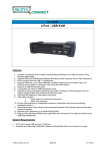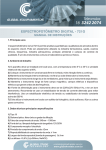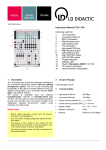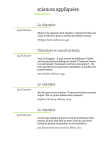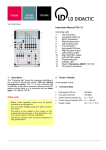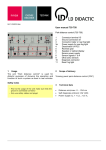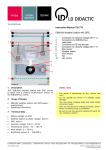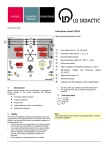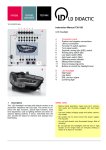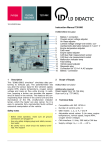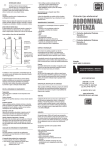Download User manual - LD Didactic
Transcript
09/13-W2010-Wei 1 2 3 4 5 6 7 8 9 Instruction Sheet 725721 725721G Three-phase Generator 10 0 11 12 13 14 15 16 Design Both devices 725 721 and 725 721G have identical functionality. The 725 721G is a portable desktop device, complete with housing and ready for connection. The 725 721 is a 19ˮ rack panel version for fixed mounting in an appropriate rack and should be used for stationary operation. 1 Safety notes The device is designed according to protection class 1 and in compliance with safety regulations VDE0100. Use this device only when correctly installed, either in a power supply rack or in desktop housing. Use this device only as a voltage source. Never connect an external voltage to the safety sockets. Changes to the setup of the experiment should only be made with the unit switched off. For connecting machine components, use only 4 mm safety experimentation leads with fixed sleeves. Caution: 96 V instantaneous values are applied at the outputs. 2 Description This unit is a frequency converter based power supply to generate DC, AC and three phase AC voltages. 1 LED indicates overcurrent (I>>). LED indicates operating mode: yellow: Umax 3~ = 14 V red: Umax 3~ = 24 V. 2 Display with 3 7-segment modules indicates: the frequency in the 0.01 Hz – 500 Hz range, the position in the 0 ° - 359 ° range, the rotational speed R in the 1 … 999 rpm and 1.00 x 1000 … 6.00 x 1000 rpm ranges. 3 3 LEDs indicate the units of measurement corresponding to the values shown in the display (2). 4 Display with three 7-segment modules to indicate the phase voltage of the AC or DC outputs. In normal operation, the rms voltage value for AC or threephase voltage is displayed. If the DC voltage changes, this value is displayed for a short time. 5 Button to set the output frequency to the mains frequency. Possible frequencies are either 50 Hz or 60 Hz, selected automatically. LED indicates when the fixed frequency is active. Pressing the button again or simply changing the frequency deactivates this mode. 6 Button to activate the “Stepˮ operation. In this mode, the rotating field position is set and can be shifted in 1 ° steps by turning the rotary encoder (12) in the forward or reverse direction. LED indicates when the operating mode is active. Mode is deactivated by pressing the button again. 7 Button to select a sine or block-shaped voltage modulation of the AC output voltage, with LED to indicate the selection. Instruction Sheet 725 721 8 9 10 11 12 13 14 15 16 3 Button for selection of AC (1) or three-phase voltage (3). In the single-phase operation, voltage is only applied between U and N; in the three-phase operation, sockets U, V and W are active. LED indicates the selected operating mode. If this button is held pressed during power on, the maximum line voltage in 3~ mode is increased to 41 V. Button to change the phase sequence for selecting the field rotation direction, LED indicates the rotation direction. Illuminated power switch. Rotary encoder for adjusting the frequency or position of the field set with the “Stepˮ button (6). A clockwise turn increases the value, while a counterclockwise turn reduces it: 0.01 – 0.09 Hz in 0.01 Hz steps 0.1 – 0.9 Hz in 0.1 Hz steps 1 – 9.5 Hz in 0.5 Hz steps 10 – 99 Hz in 1 Hz steps 100 – 500 Hz in 5 Hz steps Safety sockets for three-phase or AC voltage. In AC operation mode, a maximum of 24 V can be drawn between N and the phase conductor U. In 3~ mode, 24 V or 41 V can be obtained between the phase conductors U-V-W (see point 8) and 14 V or 24 V between the phase conductor and N respectively. The outputs are short-circuit-proof. Rotary encoder for setting the AC voltage. Turning clockwise increases the value, turning counterclockwise reduces it. Pressing wheel inward against the front panel toggles voltage on and off, with state indicated by LED. 6-pin DIN socket for the rotor position sensor 727 812. If connected, “BLDCˮ mode is automatically activated. LED activated when rotor position sensor is connected. The rotor position sensor only works with the ELM magnet rotor 563 19 or ELM 4 pole magnet rotor 563 191 manufactured after May 2012. In BLDC mode, buttons 5-9 are deactivated. Rotary encoder for setting the DC voltage. A clockwise turn increases voltage, while turning counterclockwise reduces it. Pressing the wheel inward against the front panel toggles the voltage on and off. LED indicates the on/off state. Safety sockets provide a maximum DC voltage of 15 V. Positive is applied to the red socket, negative is applied to the blue socket. The outputs are short-circuit-proof. Page 2/2 4 Technical data 3 HU rack panel equipped with illuminated power switch Output voltage AC 0…24 V Output voltage 3~ 3 x 0…24 V/41 V Output voltage DC 0…15 V All outputs are short-circuit-proof. Voltage generation: Sine or block commutated pulse width modulation Output current 1.5 A Output frequency 10 mHz to 500 Hz, adjustable Intermediate circuit voltage 96 V= Outputs 6 x 4 mm safety sockets Mains connection 725721: 5-pin connector system with leading protective contact, wired and ready for connection 725721G IEC socket C13 Width: 56 DU (depth units) Usage The electronic three-phase generator 725 721 or 725 721G enables the generation of variable frequency and variable amplitude small AC voltages and three-phase AC voltages by means of PWM and DC voltages. Two different waveforms are available to simultaneously perform experiments in AC and three-phase fields. The electronic three-phase generator is used for powering Electric Training Machines (ELM) in the geared towards Electrical Engineering and Automotive Technology A 2.7.2.2. Here it is meant for powering three-phase, AC and DC machines including the linear motor. LD DIDACTIC GMBH Leyboldstrasse 1 D-50354 Hürth Phone (02233) 604-0 Fax (02233) 604-222 e-mail: [email protected] by LD Didactic GmbH Printed in the Federal Republic of Germany Technical alterations reserved


